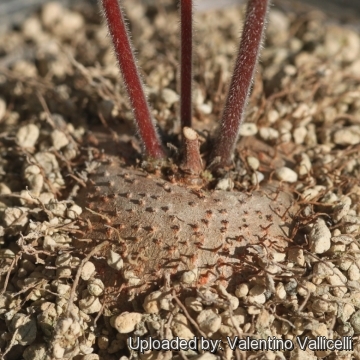




Your support is critical to our success.

Origin and Habitat: Rio Grande do Sul and Santa Catarina states (Brazil, Southern America)
Habitat: Sinningia nivalisSN|25987]]SN|25987]] dwells in high winding mountainous terrain, with the tubers partially exposed on bare rock on step cliff faces without much shade. It probably gets pretty cold there in winter and is occasionally covered by snow.
Synonyms:
- Sinningia nivalis Chautems
Description: Sinningia nivalis is a hardy, winter deciduous species with round large tubers producing several narrow, tubular, flower clusters at apex.
Related species: Sinningia nivalis belongs to group of species (led by Sinningia douglasii) which share characteristics pinkish-purple flowers with prominent longitudinal streaks inside the corolla or outside or both. Some other species in this group are Sinningia rupicola, Sinningia piresiana, plus the enigmatic Sinningia sp. Desafinado.
Tuber: Perennial, flattened spherical, fleshy but solid partially exposed above ground. Tubers are storage organs that allow the plant to survive periods of drought, cold or other conditions inhospitable to growth.
Annual stems: About 10 cm tall, completely deciduous, stumps remain on tuber. The stem growth habit is determinate (the branch stems ends with 2 or 3 leaf-pairs or flower, then stops and is unable to grow further) Dormancy appears to be obligate.
Leaves: Resemble those of Sinningia douglasii.
Bibliography: Major references and further lectures
1) Araujo, A.O.; Chautems, A. "Gesneriaceae" in Lista de Espécies da Flora do Brasil. Jardim Botânico do Rio de Janeiro. Disponível em: <http://reflora.jbrj.gov.br/jabot/floradobrasil/FB7921>. Acesso em: 22 Jan. 2014 .
2) Chautems, A., Lopes, T.C.C., Peixoto, M. & Rossini, J. “Taxonomic revision of Sinningia Nees (Gesneriaceae) IV: six new species from Brazil and a long overlooked taxon.” Candollea 65(2): 241-266.2010
3) Perret, M., Chautems, A. & Spichiger, R. “Dispersal vicariance analyses in the tribe Sinningieae (Gesneriaceae): a clue to understanding biogeographical history of the Brazilian Atlantic Forest.” Annals of Missouri Botanic Garden, 93:340-358 2006

Sinningia nivalis Photo by: Valentino Vallicelli

Sinningia nivalis Photo by: Valentino Vallicelli
Cultivation and Propagation: Sinningia nivalisSN|25987]]SN|25987]] has a dormant period after flowering (winter rest) and comes into growth in early spring. After a period of dormancy the tuber will send up new growth and the cycle will repeat.
Hardiness: This species is supposed to be more tolerant of cold than other sinningias and it is also mentioned that it can withstand brief exposures to temperatures of -7 C.
Soil: Use a lime free soil that retains water yet drains well with a little added pumice will suffice.
Pots: Always use a pot with a hole and provide a good drainage.
Watering: Drench the soil and let it become moderately dry between waterings when it is in growth and during the winter or dormant season must be kept very much on the dry side. Perpetually wet soil may result in rotting of the tuber, while dry conditions will usually induce premature dormancy.
Fertilization: Needs a regular light fertilization during growing season including all micro nutrients and trace elements or slow release fertilizer at the rate of 1/4 the dose indicated in the label. However some of the more robust cultivars will respond favourably to a more concentrated solution, and some of the smaller cultivars need very little feeding.
Exposures: It requires bright conditions, but not sun and can be grown eventually under bright fluorescent lights or in a greenhouse and many tolerate windowsill conditions if humidity can be kept up and bright light provided without too much direct sun.
Pest & diseases: Prone to mealy bugs. Always inspect any new plant for pests before introducing it to your home or greenhouse.
| Your Actions | |
|---|---|
| Back to Sinningia index | |
| Back to Gesneriaceae index | |
 |
Back to Succulents Encyclopedia index |
Privacy stantement - Terms and conditions - How to cite - About us - Feedback - Donate




